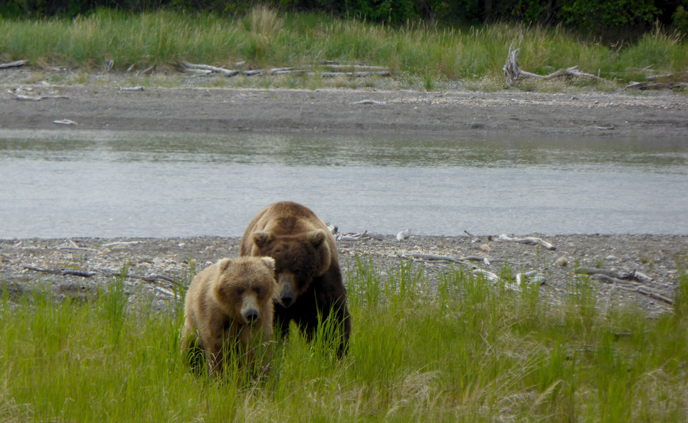
Adult male bears can grow significantly larger than adult females. NPS/M. Fitz.
Is this a mom and cub? Nope. It is a courting pair of bears. In the photo above bear 856, a large adult male, dwarfs 854 Divot, an average-sized adult female. Bears in Katmai grow large, very large, but adult females weigh one-third to one-half as much as adult males. For example, adult males average 700-900 pounds (272-408 kg) in mid summer! By October, well fed, large-bodied males can tip the scales above 1000 pounds (454 kg). Why do male bears grow so much larger than females? What advantages does large size confer to male bears? Competition for food and mates may provide answers.
Access to abundant food is one reason Katmai’s brown bears grow so large. Salmon are typically very abundant from mid to late summer throughout the park, and bears eat a lot of salmon. One evening last July, I watched 856 catch and eat about 18 whole sockeye salmon in five hours. Before they spawn, each sockeye contains about 4500 calories, which means 856 consumed over 80,000 calories in a single evening. Without this incredibly rich diet of salmon, Katmai’s bears could not grown as large as they do.
On the Alaska Peninsula, the majority of a bear’s yearly calories may come from salmon, but might there be other factors that contribute to a bear’s overall size? When bears are viewed through the lens of natural selection, bigness can provide advantages that smallness can’t.
Large, dominant males not only have greater access to food, they also have greater access to females. If bigger males were able to consistently gain greater access to females and, in turn, they sire more offspring, then over time their genes for larger size will be passed on to the next generation of bears. Successive generations of bears, therefore, would be selected to grow larger. Since males compete with each other for access to females, then competition may be the key to understanding why male bears grow so large.
Larger females, in turn, may also compete better for access to food—giving them health and reproductive advantages. Bears face stiff competition from each other and size, it seems, plays a significant role in the fitness of these animals.
